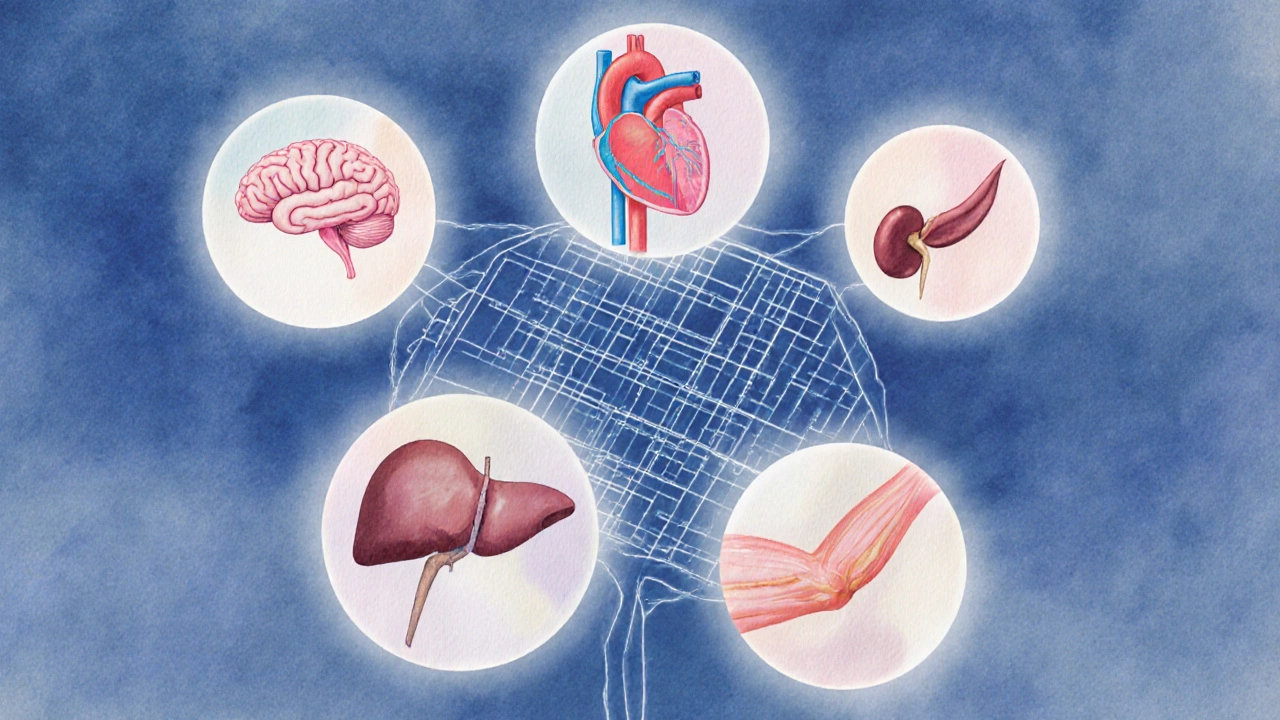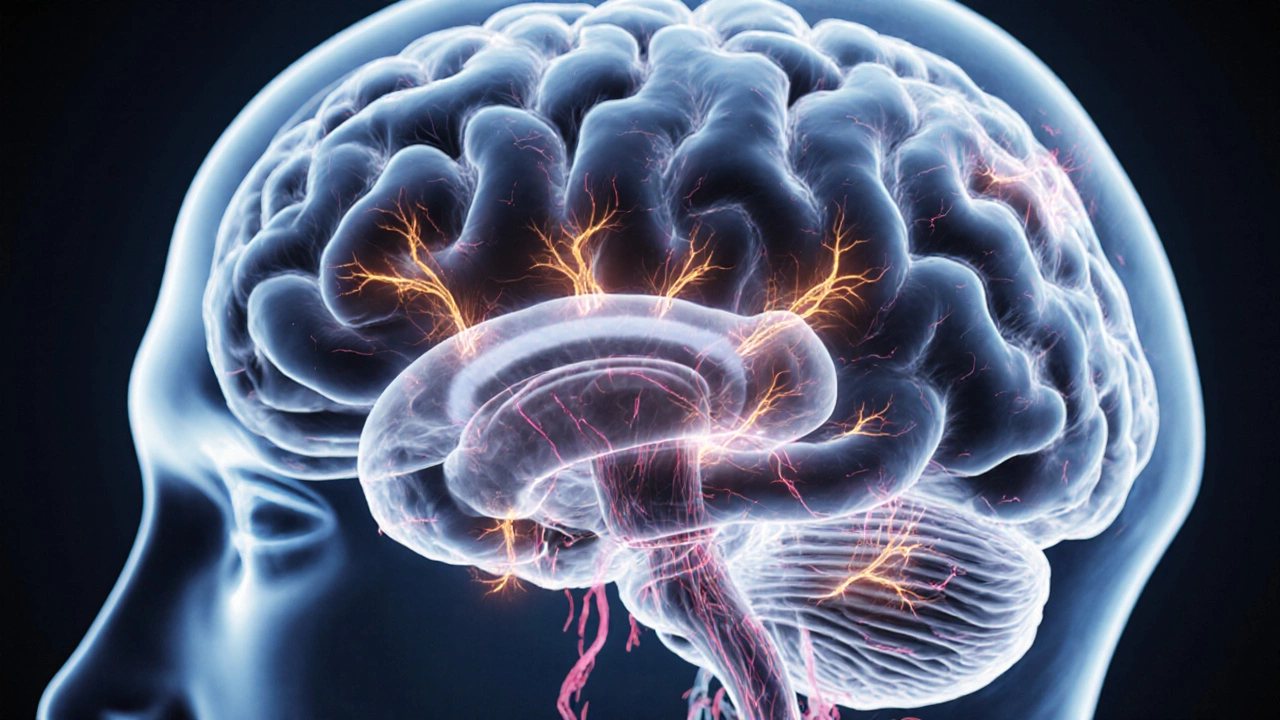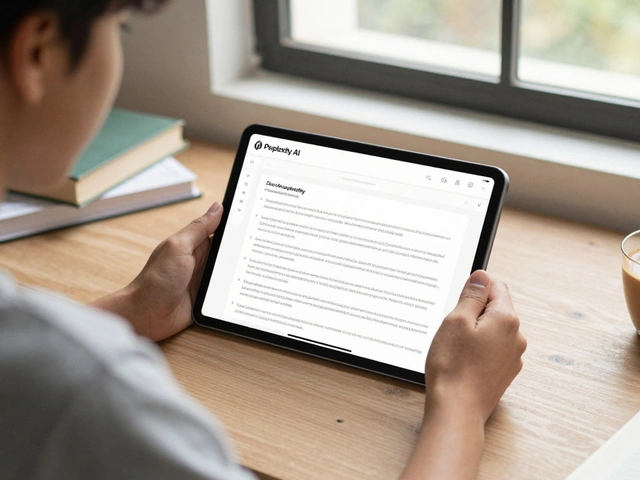Body Organ Energy Consumption Calculator
Organ Energy Distribution
Brain
20% of BMR
~300-400 kcal/day
Heart
10% of BMR
~70-90 kcal/day
Liver
10% of BMR
~70-90 kcal/day
Kidneys
14% of BMR
~100-120 kcal/day
Skeletal Muscles
20% of BMR
~300-350 kcal/day
Your Results
Based on your inputs:
- Brain: 0 kcal/day
- Heart: 0 kcal/day
- Liver: 0 kcal/day
- Kidneys: 0 kcal/day
- Skeletal Muscles: 0 kcal/day
Tip: Regular physical activity increases muscle energy use during exercise, but the brain remains the highest consumer at rest.
Key Takeaways
- The brain uses about 20% of the body's resting energy despite being only 2% of body weight.
- The heart and liver each account for roughly 10% of basal energy use.
- Kidneys and skeletal muscles together consume another 20% of resting calories.
- Energy use is measured by oxygen consumption (VO₂) and caloric expenditure.
- Factors like temperature, stress, and activity level can shift the energy budget dramatically.
Ever wondered which part of you burns the most fuel while you’re just sitting still? The short answer is the body organ energy consumption champion: your brain. Below we break down why the brain tops the list, how other organs rank, and what that means for everyday health.
Understanding Energy Use in the Human Body
All living cells need adenosine triphosphate (ATP the primary energy carrier that powers biochemical reactions) to function. The total energy your body burns at rest is called the basal metabolic rate (BMR). BMR is measured in kilocalories (kcal) per day and varies by age, sex, body composition, and genetics.
The Brain: The Energy‑Hungry Organ
Brain a 1.4‑kg organ responsible for cognition, control of heartbeat, breathing, and many automatic functions consumes roughly 120g of glucose daily-about 20% of the body’s total resting energy. This translates to 300-400kcal per day for an average adult. The high demand comes from constant electrical signaling, neurotransmitter recycling, and the work of mitochondria cellular power plants that produce ATP inside neurons.
Even when you’re asleep, the brain’s oxygen uptake stays near 20ml·kg⁻¹·min⁻¹, a rate comparable to light exercise. That’s why prolonged fasting or severe calorie restriction quickly impairs concentration-your brain simply can’t afford a big energy cut.

Heart and Liver: Heavy Lifters
The Heart a muscular organ that pumps blood continuously throughout life burns about 10% of resting calories, roughly 70-90kcal per day. Its high metabolic rate is driven by the need to maintain contractile force and ion gradients across cardiac cells.
The Liver the body’s central metabolic hub that processes nutrients, detoxifies blood, and stores glycogen also accounts for about 10% of BMR. It performs countless enzymatic reactions, synthesizes proteins, and generates glucose through gluconeogenesis, all of which demand ATP.
Kidneys and Skeletal Muscles: The Unsung Consumers
Each Kidney a paired organ that filters blood, balances electrolytes, and regulates fluid volume uses roughly 7% of resting energy. Together, both kidneys consume about 15kcal per hour, a surprisingly high figure given their modest size.
Skeletal muscle the contractile tissue responsible for locomotion and posture contributes another 20% of basal energy use, even at rest. Muscle cells maintain ion gradients, repair proteins, and sustain low‑level tension, all of which cost ATP.
How Energy Consumption Is Measured
Scientists quantify organ energy use primarily through two methods:
- Oxygen consumption (VO₂): Since oxidative phosphorylation in mitochondria uses O₂ to make ATP, measuring O₂ uptake provides a direct proxy for energy expenditure.
- Calorimetry: Indirect calorimetry calculates calories burned from O₂ and CO₂ exchange, while direct calorimetry measures heat production.
Advanced imaging like PET scans can also trace glucose uptake in specific organs, confirming that the brain’s glucose consumption far outpaces other tissues.

Factors That Change Organ Metabolism
While the percentages above hold for a typical adult at rest, several variables can shift the balance:
- Temperature: Cold exposure ramps up brown‑fat activity and liver thermogenesis, raising their share of BMR.
- Physical activity: Exercise dramatically spikes skeletal‑muscle energy use, temporarily eclipsing the brain’s share.
- Stress hormones: Elevated cortisol can increase heart rate and liver glucose output, nudging their percentages upward.
- Age and body composition: Older adults tend to lose muscle mass, reducing muscle‑related calories and slightly increasing the brain’s relative proportion.
Practical Takeaways for Everyday Health
Knowing which organ drinks the most fuel can help you make smarter lifestyle choices:
- Support brain energy by eating regular meals rich in complex carbs, omega‑3 fatty acids, and B‑vitamins.
- Maintain heart and liver health with aerobic exercise, moderate alcohol, and a diet low in saturated fat.
- Stay hydrated to help kidneys filter efficiently, and include electrolytes after intense sweating.
- Preserve muscle mass with resistance training and adequate protein, which keeps basal metabolism higher.
Comparison of Organ Energy Use (Resting)
| Organ | % of BMR | Calories/day (kcal) | O₂ consumption (ml·kg⁻¹·min⁻¹) |
|---|---|---|---|
| Brain high‑energy organ controlling cognition | 20% | 300‑400 | 20 |
| Heart continuous blood‑pumping muscle | 10% | 70‑90 | 12‑15 |
| Liver central metabolic processing organ | 10% | 70‑90 | 10‑12 |
| Kidneys blood‑filtering pair of organs | 14% | 100‑120 | 9‑11 |
| Skeletal Muscle voluntary muscle tissue | 20% | 300‑350 | 7‑9 |
Frequently Asked Questions
Why does the brain need so much energy?
The brain constantly fires billions of neurons, maintains ion gradients, and recycles neurotransmitters. All these processes rely on ATP generated by mitochondria, making the brain a major consumer of glucose and oxygen.
Can exercise make the brain the smallest energy user?
During intense activity, skeletal muscle spikes to 40‑50% of total oxygen use, temporarily dwarfing the brain’s share. However, at rest the brain always remains the top consumer.
Does fasting affect the brain’s energy consumption?
Short‑term fasting slightly lowers glucose availability, but the brain quickly switches to ketone bodies, keeping its energy use relatively stable.
How is basal metabolic rate measured?
BMR is typically measured in a fasted, thermoneutral environment using indirect calorimetry, which calculates calorie burn from O₂ consumption and CO₂ production.
Can I boost my brain’s efficiency?
Regular aerobic exercise, adequate sleep, and a diet rich in omega‑3s, antioxidants, and B‑vitamins support mitochondrial health, helping the brain use energy more efficiently.



